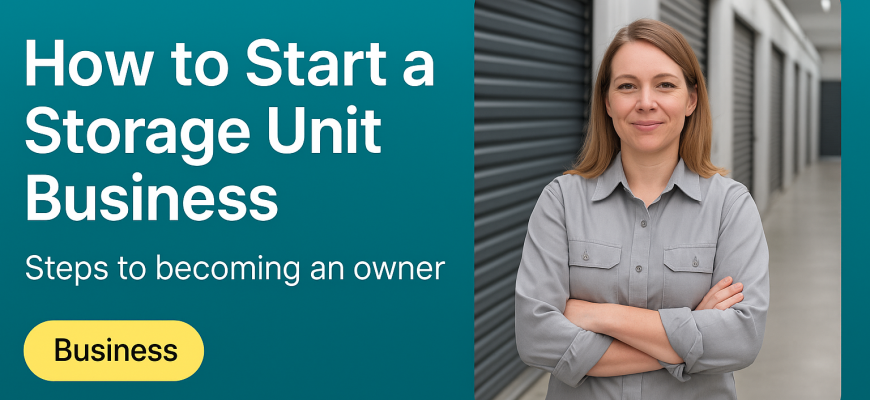The self-storage market is booming as many people are downsizing or moving homes. This growing demand means opportunity for new entrepreneurs like you. If the idea of starting a storage unit business feels intimidating, remember that the industry — once seen as male-dominated — is shifting. Women entrepreneurs are breaking stereotypes and excelling as innovators and leaders in self-storage. In fact, women often bring strong skills in communication, relationship-building, and strategic planning that help storage businesses thrive. This article walks you through how to get started, covering actionable steps, startup costs, and key legal considerations.
Step 1: Research Your Market and Create a Plan
Every successful business starts with solid research and a plan. Begin by studying your local market: Who are your potential customers, and what do they need? For example, are people in your area looking for climate-controlled units for furniture or 24-hour access for flexibility? Also, evaluate the competition – visit or research other storage facilities nearby. Note what services they offer, their unit sizes, and their pricing. This analysis will help you identify how you can differentiate your business (maybe safer facilities, better customer service, or niche offerings).
Use your research insights to write a business plan. A good business plan outlines your service offerings, target market, marketing strategy, and financial projections. It’s not just a formality – it’s your roadmap and will be crucial if you seek financing (most lenders will want to see it). Don’t worry if this is your first time writing a plan; there are templates and resources to guide you. The key is to clarify how you’ll run your storage business and turn a profit. Planning might feel like a lot of work, but it gives you confidence and direction. Remember, failing to plan is planning to fail – and you’re setting yourself up for success by doing your homework now.
Step 2: Understand the Startup Costs and Financing
One thing that can be scary about a storage business is the cost, so let’s break it down into manageable pieces. Typical startup costs for a storage facility include:
-
Property Acquisition: Buying land or an existing building (or alternatively, leasing a property) for your storage site. Location will heavily influence this cost.
-
Construction or Renovation: Building new storage units or renovating a structure. This includes site preparation (grading, paving), construction materials, labor, and installing features like fencing or drainage. (As a rule of thumb, building a new single-story facility can cost roughly $50–$65 per square foot, so costs add up quickly.)
-
Security and Equipment: Installing surveillance cameras, gates with access controls, good lighting, and alarm systems to keep the facility secure. These systems are essential and should be budgeted for.
-
Operational Setup: Initial expenses to get the business running – office setup, management software, utility hookups, and a starter supply of locks or packing materials to sell.
-
Marketing and Branding: Creating a website, signage, and advertising to attract your first customers. You’ll want to spread the word and fill those units once they’re ready!
-
Insurance and Legal Fees: The upfront cost for business insurance (more on this later) and any legal or consulting fees for setting up the business properly.
All told, even a small self-storage facility requires a significant investment. Industry guides estimate startup costs can range roughly $500,000 to $1 million for a small facility (larger operations can require several million). That figure can sound high, but don’t lose heart – there are ways to manage it. First, consider the scale of your start: you might begin with a smaller facility or even a modular approach. For example, some entrepreneurs use shipping containers as storage units to avoid lengthy construction; these ready-made units can be installed quickly and cheaply on a piece of land. Starting smaller and then expanding is absolutely okay.
Next, look into financing options to fund your startup costs. You could use personal savings or home equity, but you don’t have to go it alone. Many new owners get small business loans (the U.S. Small Business Administration offers loans that are popular for self-storage startups). Others bring on an investor or partner to share costs. Whichever route you choose, ensure you have a bit of a financial cushion for the first few months of operations in case rentals grow slowly at the beginning. The bottom line: with smart planning and the right financing, you can overcome the cost hurdle and make your storage business dream a reality.
Step 3: Find the Right Location and Set Up Shop
“Location, location, location!” applies to storage businesses too. You’ll want a spot that’s convenient for your target customers – think accessible main roads and proximity to residential or commercial areas that need storage. Visibility helps (drive-by traffic can bring in a lot of customers), as does a low-crime area that feels safe for people visiting their storage units.
Equally important is choosing a property with proper zoning for self-storage. Many municipalities restrict self-storage facilities in certain zones (for example, you usually can’t drop a storage complex in a residential neighborhood without special permission). Check your local zoning laws and make sure the land is zoned for commercial or self-storage use. If it isn’t, you might need to apply for a zoning change or a special use permit – a process worth considering if the location is perfect, but it does take time and approval from the local authorities. Often, working with a real estate agent or a local consultant can help you navigate these zoning questions early on.
Once you’ve secured a suitable location, decide how to set up your facility. Will you build new units from the ground up, or could you buy an existing storage facility and improve it? Building new lets you design the layout exactly as you want (maybe with climate-controlled sections or extra-large units for boats/RVs), but it takes more time and money upfront. Buying an existing facility or a pre-fabricated setup (like container units) might get you operating faster. Whichever path, ensure the facility has essential features: sturdy units (steel doors, solid walls), good security systems, and maybe conveniences like lighting and trolleys for customers. As you set up, also plan for scalability – if things go well, you’ll want the option to add more units or even expand to a second location in the future!
Step 4: Take Care of Legal and Regulatory Requirements
With your plan and location in place, you’ll need to handle a few legal steps to officially launch your business. Don’t worry – these might seem tedious, but they are crucial for protecting yourself and running smoothly. Key legal and regulatory considerations include:
-
Business Registration and Structure: Register your business and choose a legal structure. Many entrepreneurs form a limited liability company (LLC) to separate personal assets from business liabilities. An LLC or similar structure can protect you if anything goes wrong by legally shielding your personal finances. It’s typically easy and inexpensive to set up (often done through your state’s Secretary of State).
-
Licenses and Permits: Obtain any required business licenses from your city or state, and make sure you have the permits needed to operate. For a storage facility, this can include building permits (if you’re constructing or renovating) and adherence to local building codes and fire safety regulations. For example, many areas require facilities to have proper fire alarms, sprinkler systems, and clear access for emergency vehicles. Also double-check you have the zoning approval or permit for running a storage business on your chosen site (as noted earlier). It’s wise to get all these approvals before you open your doors.
-
Insurance Coverage: Insurance is a must-have to protect your investment. At minimum, you’ll want property insurance (to cover damage from events like fire or storms) and general liability insurance (to cover injuries or lawsuits if something happens on your property). Self-storage businesses may face risks like theft, damage to customers’ goods, or accidents on-site, so coverage is critical. Talk to an insurance agent with experience in commercial policies; they can advise if you need additional coverage such as burglary, vandalism, or even an umbrella policy for extra liability protection. It’s an added cost, but one lawsuit or disaster without insurance could sink your business – so don’t skip this.
-
Contracts and Policies: One often-overlooked item is having a solid rental agreement or contract for your customers. This document should clearly outline the terms of rental, payment due dates, what happens if someone doesn’t pay (for example, lien procedures or auctions, which many states regulate), and liability terms (typically customers are responsible for insuring their own stored items, or you may offer tenant insurance options). Consult a legal professional to draft or review your standard contract to make sure it complies with any state laws and fully protects you and is fair to your customers. Having clear policies from the start will prevent misunderstandings and legal headaches later.
Tackling the paperwork and legal details might not be the most exciting part of entrepreneurship, but it empowers you. It means you’re truly building a business on solid ground. When all these legal pieces are in place, you can operate with confidence, knowing you’re compliant and protected.
Step 5: Open Your Doors and Start Growing
With planning done, financing secured, location ready, and legal matters sorted, it’s time for the big moment – opening your self-storage business! Start with a soft launch if possible: open quietly for a week or two, work out any kinks in your processes, and then have a grand opening. In those early days, focus on providing excellent customer service to every person who walks in or calls. A friendly, helpful reputation will set you apart, and word-of-mouth (especially in local communities) is powerful.
Begin marketing your facility in your community. Use both online and offline tactics: a simple, informative website and active social media can help people find you, and local advertising or community bulletin boards can spread the word as well. Perhaps run an introductory promotion (e.g. first month free or a discount for new sign-ups) to attract your first customers. Networking is also important – connect with local real estate agents or apartment managers who can refer tenants needing storage, and consider joining small business groups or your local chamber of commerce to make business contacts. Every filled storage unit gets you one step closer to profitability, so don’t be shy about promoting what you offer.
Finally, remember that entrepreneurship is a journey. There will be challenges, but you’ve done the homework and prepared – you are ready for this. Stay adaptable and keep learning as you go (the self-storage industry has conferences, associations, and even mentoring programs for newcomers, including those focused on women in the industry). Whenever you face a hurdle, come back to your plan, consult your mentors or peers, and keep pushing forward. You’re not just building a storage unit business; you’re building your business, on your terms. Be proud of how far you’ve come already in just planning this venture. Now, take that leap and launch with confidence. The growing self-storage industry is waiting for fresh, passionate entrepreneurs like you, and there’s no reason your name can’t be among the success stories. Good luck – you’ve got this!









